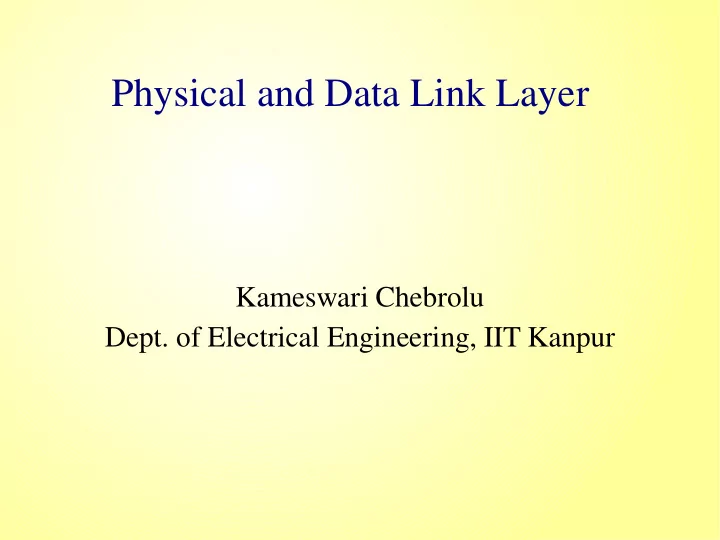

Physical and Data Link Layer Kameswari Chebrolu Dept. of Electrical Engineering, IIT Kanpur
Problem Statement ● Make two computers talk to each other Pictures courtesy Peterson & Davie
Hosts Communication end-points – PCs, Workstations, PDAs, Cellphones, Servers Pictures courtesy Google
Interface Cards/Network Adaptor Attach the host to the link Pictures courtesy Google
Links Carry signals from one place to other place(s) Cat5-twisted pair Co-axial Fiber Optics Pictures courtesy Google
Characteristics of Links ● Data Rate ● Loss rate ● Delay Link Type Typical Bandwidths Distance Twisted Pair 10-100 Mbps 100m Coaxial Cable 10-100 Mbps 200-500m Fiber Optics 100-2400 Mbps 40kms
Shannon's Theorem ● Signals attenuate with distance ● Get distorted due to noise, crosstalk, fading, multi-path ● Signal to Noise Ratio (SNR) measures these effects ● C = W log_2 (1 + S/N) bits/sec ● Data over telephone line calculation ● W = 3300Hz – 300Hz = 3000Hz; S/N = 1000 (30db); C ~ 30kbps
Encoding ● Physical media transmit Analog signals ● Modulate/demodulate: – Encode/decode binary data into signals – E.g. Non-return to Zero (NRZ) ● 0 as low signal and 1 as high signal 0 0 1 0 1 1 1 1 0 1 0 0 0 0 1 0 Bits NRZ Picture courtesy Peterson & Davie
Problems with NRZ ● Consecutive 1s and 0s – Changes the average making it difficult to detect signals ( baseline wander ) – Clock Recovery ● Sender's and receiver clocks have to be precisely synchronized ● Receiver derives the clock from the received signal vis signal transition ● Lesser number of transitions leads to clock drift
Alternative Encodings ● Non-return to Zero Inverted (NRZI) – To encode a 1, make a transition – To encode a 0, stay at the current signal – Solves problem of consecutive 1's but not 0's ● Manchester Encoding – Transmits XOR of the NRZ encoded data and the clock ● 0 is encoded as low-to-high transition, 1 as high-to-low transition – Only 50% efficient
Example 0 0 1 0 1 1 1 1 0 1 0 0 0 0 1 0 Bits NRZ Clock Manchester NRZI Picture courtesy Peterson & Davie
Recommend
More recommend